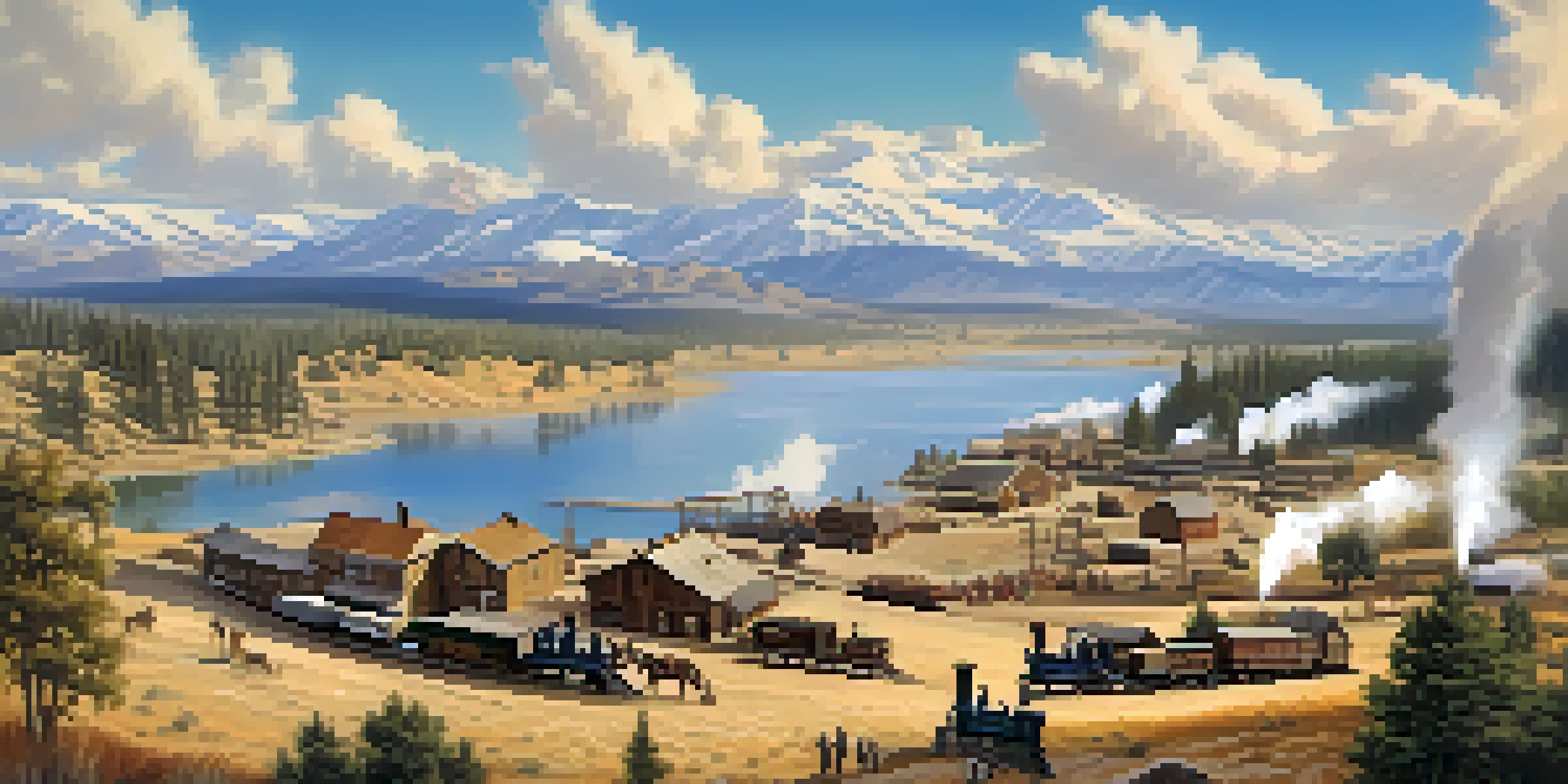The Rise of Railroads: California's Transportation Revolution

The Birth of Railroads in California's Gold Rush Era
In the mid-19th century, California was in the midst of a gold rush frenzy. As prospectors flocked to the state seeking fortune, the need for efficient transportation grew immensely. Railroads emerged as a solution, connecting bustling towns and remote mining areas, facilitating the movement of goods and people alike.
The railroads are the arteries of the nation, and they must be kept healthy and strong to ensure the economic vitality of the country.
The first significant railroad, the Central Pacific Railroad, was established in 1861. It linked Sacramento to the Sierra Nevada, allowing miners to transport gold and supplies more easily. This not only sped up the mining process but also attracted more settlers, eager to stake their claim in this booming economy.
As railroads expanded, they became essential to California’s growth, laying the groundwork for cities and industries to flourish. The transformative power of these railways marked the beginning of a transportation revolution that would change the landscape of the entire state.
Technological Innovations Driving Railroad Expansion
The railroad boom wasn't just about laying tracks; it also sparked a wave of technological innovations. Steam locomotives became faster and more powerful, enabling them to traverse challenging terrains. This advancement made it possible to connect remote regions, enhancing trade and travel across California.

Innovations like the telegraph system also played a crucial role in railroad expansion. Dispatchers could communicate with engineers and conductors instantly, allowing for better coordination and safety. These technologies transformed railroads into a highly efficient transportation network, setting the stage for modern logistics.
Railroads Fueled Economic Growth
The expansion of railroads connected isolated areas, allowing California to access broader markets and significantly boosting its economy.
Moreover, the introduction of standardized rail gauges helped unify the railway system. This meant trains could travel seamlessly across different lines, facilitating even more extensive trade routes. The combination of these innovations made railroads a cornerstone of California's economic development.
The Impact of Railroads on California's Economy
The expansion of railroads had a profound impact on California's economy. They opened up access to previously isolated areas, allowing agricultural products, minerals, and manufactured goods to reach broader markets. This connectivity catalyzed growth in various sectors, from farming to mining to manufacturing.
Without the railroads, the American West would still be a vast wilderness.
With railroads in place, California could export its goods nationwide. Cities like San Francisco and Los Angeles transformed into bustling ports of trade, attracting businesses and immigrants. This influx of commerce created jobs, further fueling the state's rapid economic expansion.
Additionally, the railroads helped reduce transportation costs significantly. Businesses could now afford to ship larger quantities of goods over longer distances, making them more competitive. The result was a flourishing economy that would establish California as a key player on the national stage.
Cultural Shifts: The Human Side of Railroad Expansion
As railroads transformed California’s economy, they also brought about significant cultural shifts. The movement of people became easier, with families migrating in search of new opportunities. This led to a rich tapestry of cultures and communities forming across the state, each contributing to California's unique identity.
Railroads facilitated the spread of ideas and lifestyles, allowing diverse groups to interact and exchange traditions. Festivals, markets, and social gatherings became more common as communities linked by railroads began to flourish. This cultural exchange enriched the social fabric of California and fostered a spirit of innovation.
Cultural Transformation Through Rail
Railroads facilitated the movement of people and ideas, leading to a rich blend of cultures and communities across California.
Furthermore, the railroads played a crucial role in shaping California's tourism industry. The beauty of the state's landscapes attracted travelers from all over, eager to experience its natural wonders. Railroads made these adventures accessible, paving the way for a vibrant tourism sector that continues to thrive today.
Challenges Faced by California's Railroads
Despite their successes, California's railroads faced numerous challenges. The vast and varied terrain posed engineering difficulties, requiring innovative solutions to lay tracks over mountains and through valleys. Additionally, financing these ambitious projects was a constant struggle, often leading to political and economic turmoil.
Labor issues also surfaced, particularly with the influx of immigrant workers who built the railroads. While these laborers were vital to railroad construction, they often faced harsh working conditions and discrimination. Strikes and labor disputes became common as workers fought for better wages and rights.
Moreover, competition from emerging transportation modes, such as automobiles and airplanes, began to threaten the railroads' dominance. As highways expanded and air travel became more accessible, railroads had to adapt to remain relevant in a rapidly changing transportation landscape.
The Legacy of Railroads in Modern California
Today, the legacy of California's railroads is evident in its vast transportation network. While the golden age of rail travel has diminished, railroads continue to play a crucial role in freight transportation. They remain a cost-effective and energy-efficient way to move goods across the state and beyond.
Moreover, the historical significance of railroads has not been forgotten. Many of California's old rail lines have been transformed into scenic trails, attracting hikers and cyclists. These trails serve as a reminder of the rich history that shaped the state's development and offer a glimpse into the past.
Challenges in Railroad Development
Despite their success, California's railroads faced engineering difficulties, labor disputes, and competition from other transportation modes.
Additionally, discussions about modernizing rail systems, such as the proposed high-speed rail, highlight the ongoing importance of rail transportation in California. As the state looks to the future, the lessons learned from its railroad history will undoubtedly influence its transportation policies and infrastructure.
Future Prospects: Railroads in a Changing World
As we look to the future, the role of railroads in California is evolving. With growing concerns about climate change and sustainability, there is renewed interest in rail transportation as a greener alternative to road and air travel. Modern technologies, such as electrification and automation, are being explored to make trains more efficient and environmentally friendly.
Moreover, the push for urban transit solutions is leading to initiatives that integrate rail systems into city planning. Commuter rail lines are being expanded to ease congestion and provide residents with reliable transportation options. This focus on public transit reflects a shift towards more sustainable urban development.

The future of railroads in California also hinges on partnerships between public and private sectors. Investments in infrastructure and technology will be crucial in ensuring that railroads remain a vital part of the state's transportation landscape. As California continues to grow, railroads may once again become the backbone of its economic and cultural connectivity.